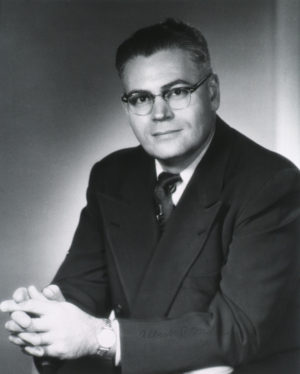
Dr. Albert McKee is shown in a 1953, two years after he led an expedition to Alaska to gather tissue samples from Inuit natives who had died in the 1918 flu pandemic. Photo courtesy of University of Iowa College of Medicine
By Diane Fannon-Langton
Two University of Iowa professors, both of them medical doctors, mounted an effort in 1951 to learn more about the Spanish flu virus that killed an estimated 21 million people worldwide, including 6,000 in Iowa, between 1918 and 1920.
The trip by Drs. Albert McKee and Jack Layton took them to a remote village in northern Alaska, 70 miles east of Siberia, to take tissue samples from Inuit natives buried in a mass grave.
In 1918, the Spanish flu killed 107 of the 115 natives living near the Brevig Mission. The deaths occurred so quickly the U.S. Army used a steam generator to thaw the permafrost and bury the victims together.
It was Dr. William Hale, who headed the University of Iowa bacteriology department, who came up with the idea in the 1940s of trying to retrieve the virus from that mass grave, thinking the permafrost may have preserved it. If it could be studied, and understood, perhaps scientists could create a vaccine that would prevent it from ever causing a worldwide pandemic again.
World War II got in the way of that, but McKee, a University of Iowa professor of microbiology, resurrected the idea in 1950. He was joined by Dr. Jack Layton, a bacteriology professor, and Johan Hultin, a University of Iowa graduate student from Sweden.
Hultin contacted a friend, Otto Geist, a research associate in paleontology at the University of Alaska, who spent a year gathering information for the team.
While waiting for that information, McKee — head of the Iowa regional influenza laboratory, one of nine World Health Organization labs in North America — continued to research flu outbreaks and new flu vaccines.
“By our reporting process, we know where the epidemic areas are at all times all over the country and which way they are moving,” he said. “Our aim is constant research as well as providing information which can stop an outbreak before it becomes an epidemic, and to provide information for the use of different vaccines in the epidemic areas.”
In March 1951, McKee developed a vaccine for an Influenza A strain. Four months later, he headed to Alaska.
Off to Alaska
McKee, Layton and Hultin met in Fairbanks in July 1951, where they waited for clearance from the U.S. Department of the Interior; the Alaska governor; Hugh G. Wade, a 1924 University of Iowa law school graduate who was director of Alaska Native Service; the U.S. Public Health Service; and the territorial commissioner of health, whose assistant had once been a professor at the University of Iowa.
They then went to Nome to talk with Joseph Kehoe, a judge in the Alaskan Territory, and, ultimately, with the council of natives from the remote Brevig Mission and the relatives of those who had died in 1918.
One older native told the researchers his wife was one of those killed by the virus.
The council gave the Iowans permission to take samples from the mass grave.
TO READ THE ENTIRE STORY AND OTHER FASCINATING STORIES ABOUT IOWA HISTORY, subscribe to Iowa History Journal.
